Abstract
Negatively charged phospholipids accelerate blood coagulation; one suggestion is that the binding of the gamma-carboxyglutamic acid-containing zymogens to these lipid surfaces increases their effective concentration as substrates. Alternatively, the charged phospholipids could enhance the direct interaction of substrate with the catalytic complex, which is localized at the membrane surface. We distinguished the alternatives by using prothrombin fragment 1 to compete with the substrate for membrane binding sites without interfering with the direct enzyme-substrate interaction. In a tissue factor-factor VIIa system containing neutral phospholipids (to which the substrate does not bind), prothrombin fragment 1 had no significant effect on factor X activation (Km, 877 +/- 111 nM and 791 +/- 103 nM, with and without prothrombin fragment 1, respectively). In contrast, in a system containing 30% phosphatidylserine, prothrombin fragment 1 displaced phospholipid-bound factor X, increasing the free factor X concentration and the reaction velocity in all 22 determinations. As the velocity increases correlated only with the free factor X concentration, we conclude that the free factor X concentration controls this reaction velocity. The Km in the 30% phosphatidylserine system, calculated using free factor X concentration, was 41 +/- 5 nM and 63 +/- 9 nM, with and without prothrombin fragment 1, respectively. Thus, the negatively charged lipids decreased the intrinsic Km by over 90%. The methodology employed should be applicable to ligand-receptor systems in which ligand binds nonspecifically to the membrane surface.
Full text
PDF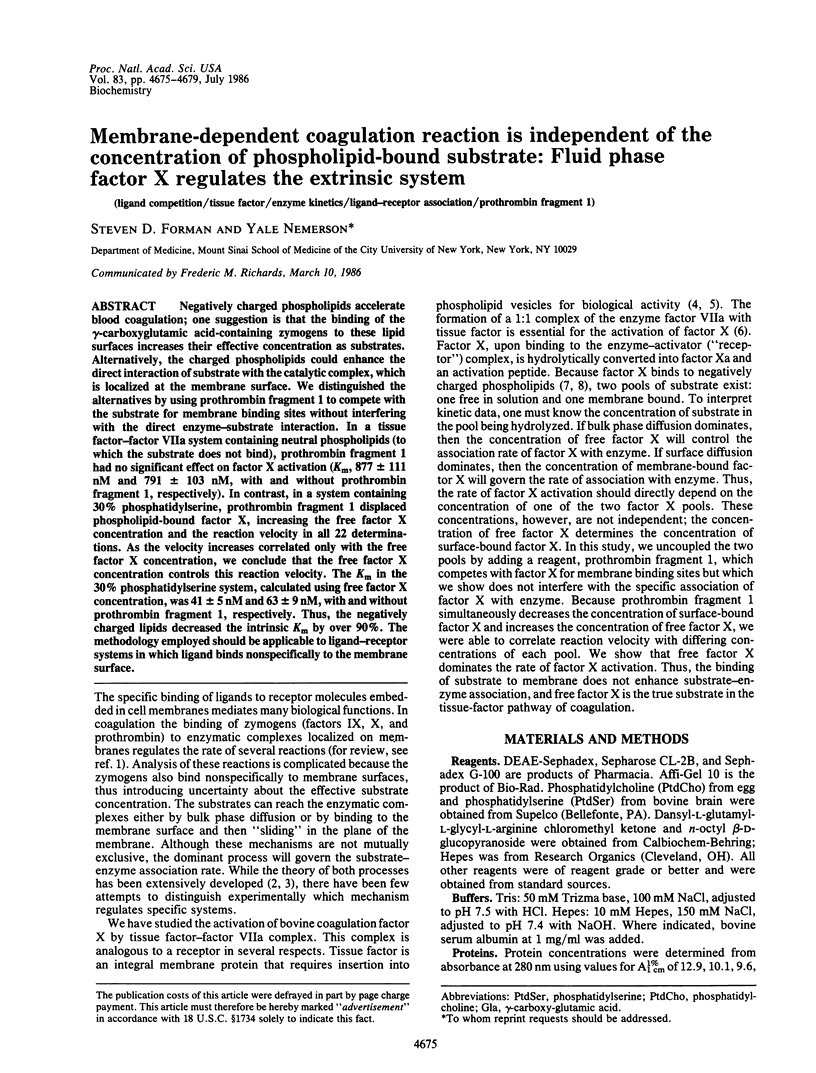
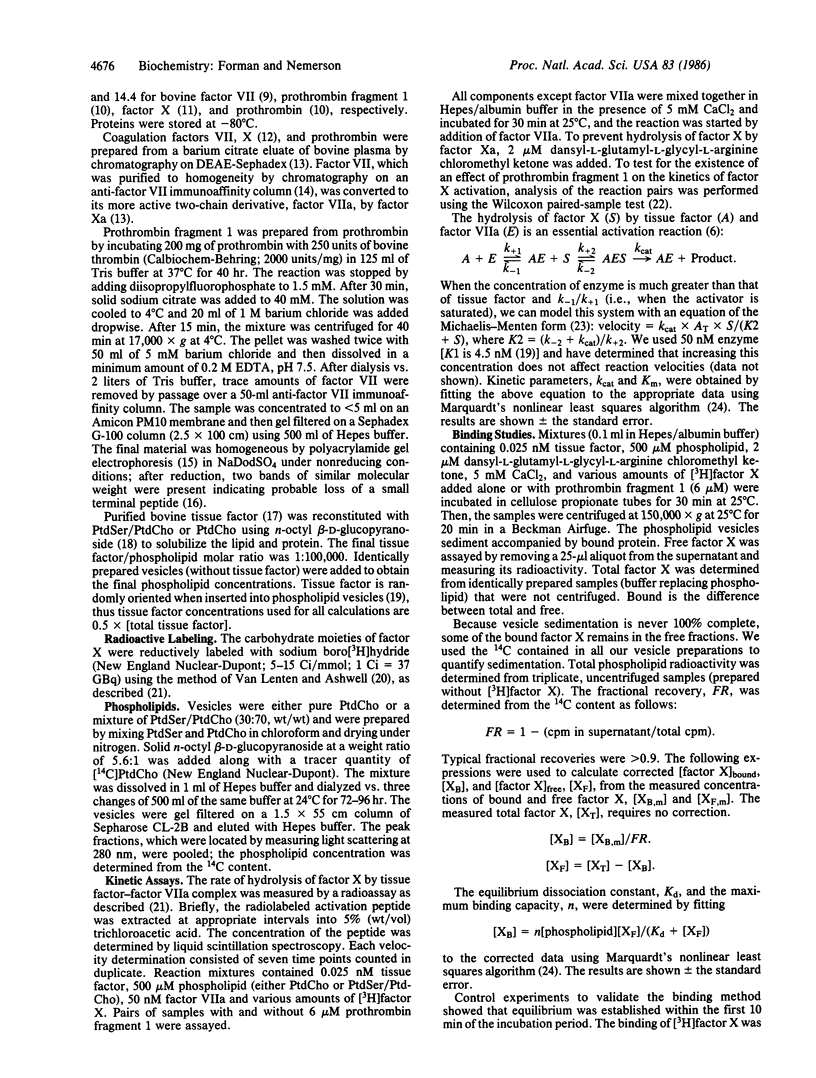
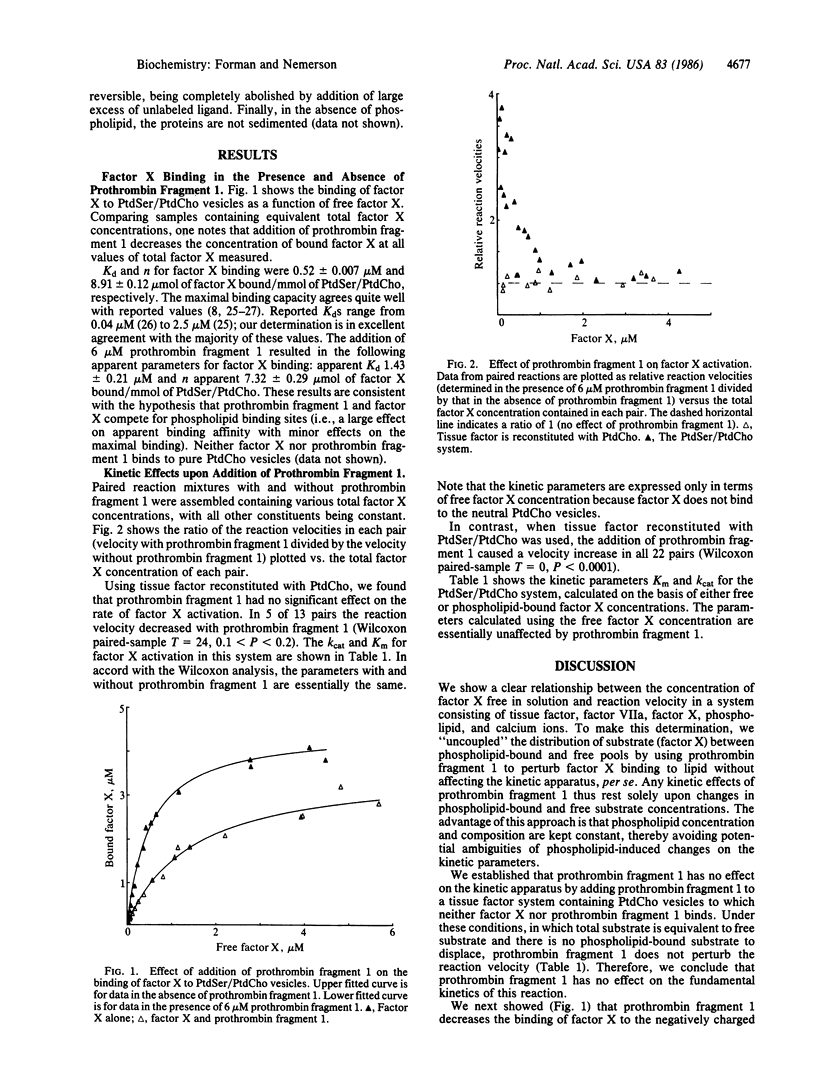
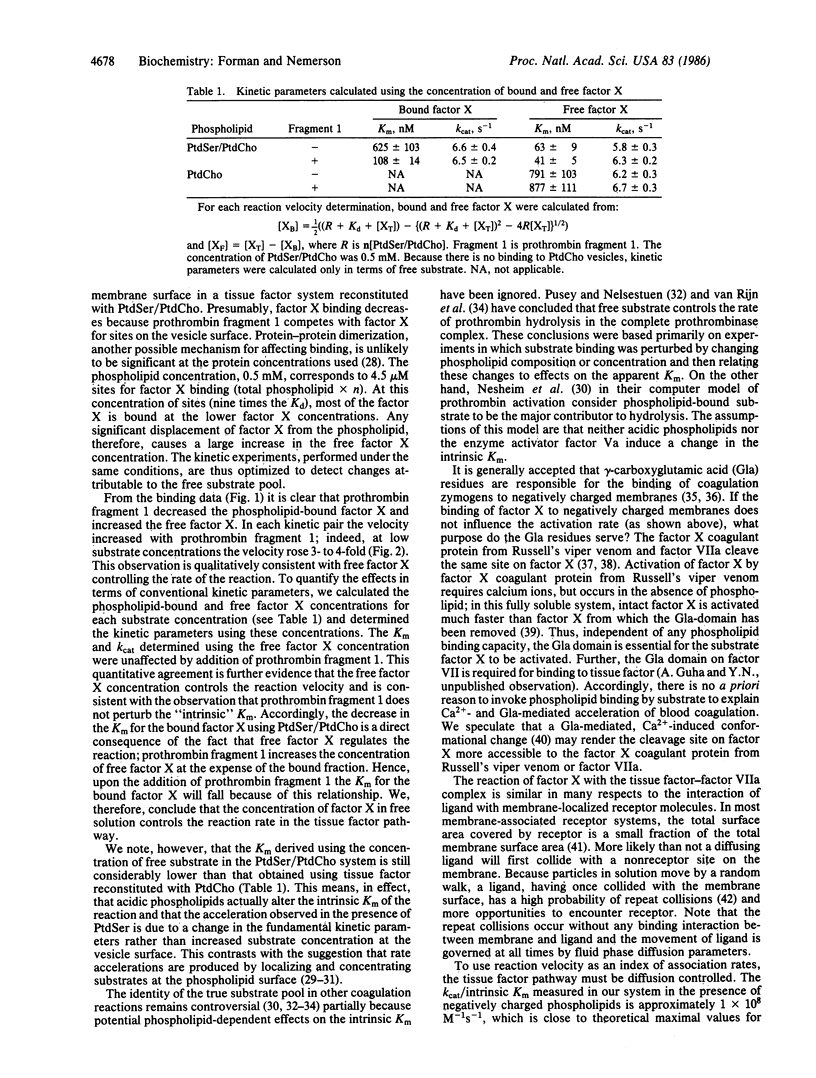
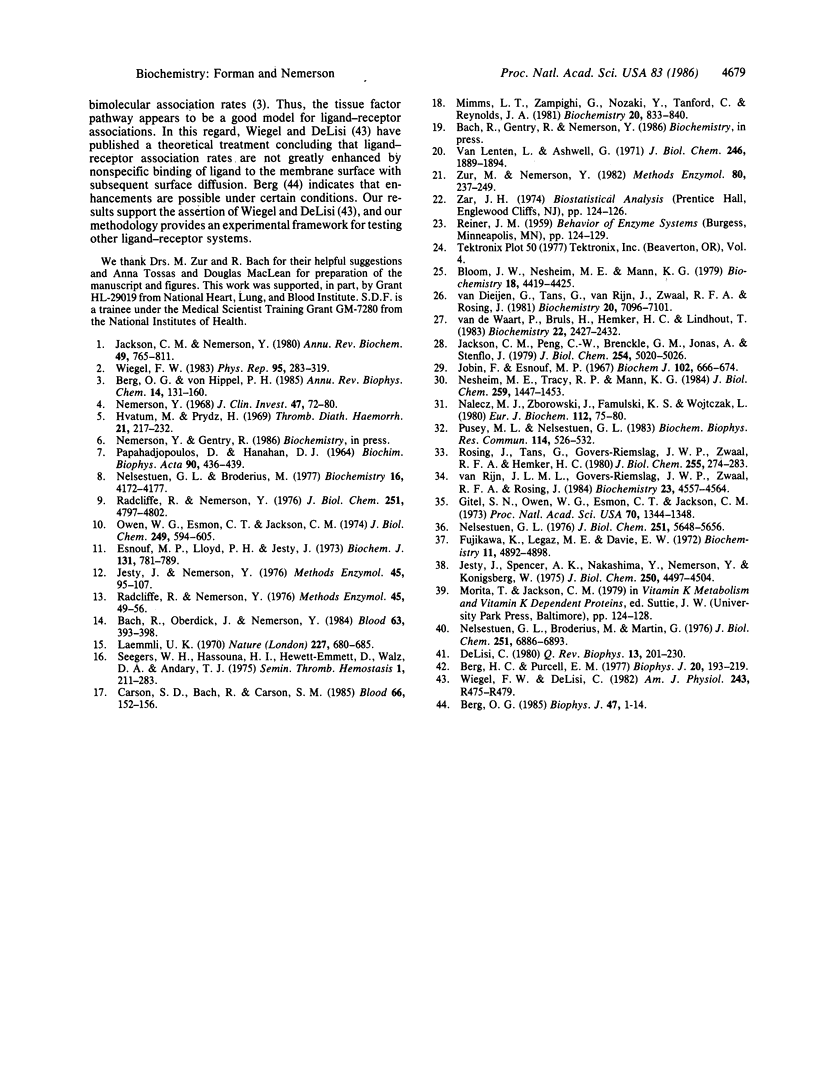
Selected References
These references are in PubMed. This may not be the complete list of references from this article.
- Bach R., Oberdick J., Nemerson Y. Immunoaffinity purification of bovine factor VII. Blood. 1984 Feb;63(2):393–398. [PubMed] [Google Scholar]
- Berg H. C., Purcell E. M. Physics of chemoreception. Biophys J. 1977 Nov;20(2):193–219. doi: 10.1016/S0006-3495(77)85544-6. [DOI] [PMC free article] [PubMed] [Google Scholar]
- Berg O. G. Orientation constraints in diffusion-limited macromolecular association. The role of surface diffusion as a rate-enhancing mechanism. Biophys J. 1985 Jan;47(1):1–14. doi: 10.1016/S0006-3495(85)83870-4. [DOI] [PMC free article] [PubMed] [Google Scholar]
- Berg O. G., von Hippel P. H. Diffusion-controlled macromolecular interactions. Annu Rev Biophys Biophys Chem. 1985;14:131–160. doi: 10.1146/annurev.bb.14.060185.001023. [DOI] [PubMed] [Google Scholar]
- Bloom J. W., Nesheim M. E., Mann K. G. Phospholipid-binding properties of bovine factor V and factor Va. Biochemistry. 1979 Oct 2;18(20):4419–4425. doi: 10.1021/bi00587a023. [DOI] [PubMed] [Google Scholar]
- Carson S. D., Bach R., Carson S. M. Monoclonal antibodies against bovine tissue factor, which block interaction with factor VIIa. Blood. 1985 Jul;66(1):152–156. [PubMed] [Google Scholar]
- DeLisi C. The biophysics of ligand-receptor interactions. Q Rev Biophys. 1980 May;13(2):201–230. doi: 10.1017/s0033583500001657. [DOI] [PubMed] [Google Scholar]
- Esnouf M. P., Lloyd P. H., Jesty J. A method for the simultaneous isolation of factor X and prothrombin from bovine plasma. Biochem J. 1973 Apr;131(4):781–789. doi: 10.1042/bj1310781. [DOI] [PMC free article] [PubMed] [Google Scholar]
- Fujikawa K., Legaz M. E., Davie E. W. Bovine factor X 1 (Stuart factor). Mechanism of activation by protein from Russell's viper venom. Biochemistry. 1972 Dec 19;11(26):4892–4899. doi: 10.1021/bi00776a003. [DOI] [PubMed] [Google Scholar]
- Gitel S. N., Owen W. G., Esmon C. T., Jackson C. M. A polypeptide region of bovine prothrombin specific for binding to phospholipids. Proc Natl Acad Sci U S A. 1973 May;70(5):1344–1348. doi: 10.1073/pnas.70.5.1344. [DOI] [PMC free article] [PubMed] [Google Scholar]
- Hvatum M., Prydz H. Studies on tissue thromboplastin--its splitting into two separable parts. Thromb Diath Haemorrh. 1969 Apr 30;21(2):217–222. [PubMed] [Google Scholar]
- Jackson C. M., Nemerson Y. Blood coagulation. Annu Rev Biochem. 1980;49:765–811. doi: 10.1146/annurev.bi.49.070180.004001. [DOI] [PubMed] [Google Scholar]
- Jackson C. M., Peng C. W., Brenckle G. M., Jonas A., Stenflo J. Multiple modes of association in bovine prothrombin and its proteolysis products. J Biol Chem. 1979 Jun 25;254(12):5020–5026. [PubMed] [Google Scholar]
- Jesty J., Nemerson Y. The activation of bovine coagulation factor X. Methods Enzymol. 1976;45:95–107. doi: 10.1016/s0076-6879(76)45014-0. [DOI] [PubMed] [Google Scholar]
- Jesty J., Spencer A. K., Nakashima Y., Nemerson Y., Konigsberg W. The activation of coagulation factor X. Identity of cleavage sites in the alternative activation pathways and characterization of the COOH-terminal peptide. J Biol Chem. 1975 Jun 25;250(12):4497–4504. [PubMed] [Google Scholar]
- Jobin F., Esnouf M. P. Studies on the formation of the prothrombin-converting complex. Biochem J. 1967 Mar;102(3):666–674. doi: 10.1042/bj1020666. [DOI] [PMC free article] [PubMed] [Google Scholar]
- Laemmli U. K. Cleavage of structural proteins during the assembly of the head of bacteriophage T4. Nature. 1970 Aug 15;227(5259):680–685. doi: 10.1038/227680a0. [DOI] [PubMed] [Google Scholar]
- Mimms L. T., Zampighi G., Nozaki Y., Tanford C., Reynolds J. A. Phospholipid vesicle formation and transmembrane protein incorporation using octyl glucoside. Biochemistry. 1981 Feb 17;20(4):833–840. doi: 10.1021/bi00507a028. [DOI] [PubMed] [Google Scholar]
- Nałecz M. J., Zborowski J., Famulski K. S., Wojtczak L. Effect of phospholipid composition on the surface potential of liposomes and the activity of enzymes incorporated. Eur J Biochem. 1980 Nov;112(1):75–80. doi: 10.1111/j.1432-1033.1980.tb04988.x. [DOI] [PubMed] [Google Scholar]
- Nelsestuen G. L., Broderius M. Interaction of prothrombin and blood-clotting factor X with membranes of varying composition. Biochemistry. 1977 Sep 20;16(19):4172–4177. doi: 10.1021/bi00638a006. [DOI] [PubMed] [Google Scholar]
- Nelsestuen G. L., Broderius M., Martin G. Role of gamma-carboxyglutamic acid. Cation specificity of prothrombin and factor X-phospholipid binding. J Biol Chem. 1976 Nov 25;251(22):6886–6893. [PubMed] [Google Scholar]
- Nelsestuen G. L. Role of gamma-carboxyglutamic acid. An unusual protein transition required for the calcium-dependent binding of prothrombin to phospholipid. J Biol Chem. 1976 Sep 25;251(18):5648–5656. [PubMed] [Google Scholar]
- Nemerson Y. The phospholipid requirement of tissue factor in blood coagulation. J Clin Invest. 1968 Jan;47(1):72–80. doi: 10.1172/JCI105716. [DOI] [PMC free article] [PubMed] [Google Scholar]
- Nesheim M. E., Tracy R. P., Mann K. G. "Clotspeed," a mathematical simulation of the functional properties of prothrombinase. J Biol Chem. 1984 Feb 10;259(3):1447–1453. [PubMed] [Google Scholar]
- Owen W. G., Esmon C. T., Jackson C. M. The conversion of prothrombin to thrombin. I. Characterization of the reaction products formed during the activation of bovine prothrombin. J Biol Chem. 1974 Jan 25;249(2):594–605. [PubMed] [Google Scholar]
- PAPAHADJOPOULOS D., HANAHAN D. J. OBSERVATIONS ON THE INTERACTION OF PHOSPHOLIPIDS AND CERTAIN CLOTTING FACTORS IN PROTHROMBIN ACTIVATOR FORMATION. Biochim Biophys Acta. 1964 Aug 19;90:436–439. doi: 10.1016/0304-4165(64)90220-x. [DOI] [PubMed] [Google Scholar]
- Pusey M. L., Nelsestuen G. L. The physical significance of Km in the prothrombinase reaction. Biochem Biophys Res Commun. 1983 Jul 29;114(2):526–532. doi: 10.1016/0006-291x(83)90812-4. [DOI] [PubMed] [Google Scholar]
- Radcliffe R., Nemerson Y. Bovine factor VII. Methods Enzymol. 1976;45:49–56. doi: 10.1016/s0076-6879(76)45008-5. [DOI] [PubMed] [Google Scholar]
- Radcliffe R., Nemerson Y. Mechanism of activation of bovine factor VII. Products of cleavage by factor Xa. J Biol Chem. 1976 Aug 25;251(16):4749–4802. [PubMed] [Google Scholar]
- Rosing J., Tans G., Govers-Riemslag J. W., Zwaal R. F., Hemker H. C. The role of phospholipids and factor Va in the prothrombinase complex. J Biol Chem. 1980 Jan 10;255(1):274–283. [PubMed] [Google Scholar]
- Van Lenten L., Ashwell G. Studies on the chemical and enzymatic modification of glycoproteins. A general method for the tritiation of sialic acid-containing glycoproteins. J Biol Chem. 1971 Mar 25;246(6):1889–1894. [PubMed] [Google Scholar]
- Wiegel F. W., DeLisi C. Evaluation of reaction rate enhancement by reduction in dimensionality. Am J Physiol. 1982 Nov;243(5):R475–R479. doi: 10.1152/ajpregu.1982.243.5.R475. [DOI] [PubMed] [Google Scholar]
- van Dieijen G., Tans G., van Rijn J., Zwaal R. F., Rosing J. Simple and rapid method to determine the binding of blood clotting factor X to phospholipid vesicles. Biochemistry. 1981 Dec 8;20(25):7096–7101. doi: 10.1021/bi00528a007. [DOI] [PubMed] [Google Scholar]
- van Rijn J. L., Govers-Riemslag J. W., Zwaal R. F., Rosing J. Kinetic studies of prothrombin activation: effect of factor Va and phospholipids on the formation of the enzyme-substrate complex. Biochemistry. 1984 Sep 25;23(20):4557–4564. doi: 10.1021/bi00315a008. [DOI] [PubMed] [Google Scholar]
- van de Waart P., Bruls H., Hemker H. C., Lindhout T. Interaction of bovine blood clotting factor Va and its subunits with phospholipid vesicles. Biochemistry. 1983 May 10;22(10):2427–2432. doi: 10.1021/bi00279a019. [DOI] [PubMed] [Google Scholar]


